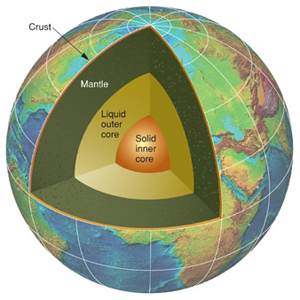I generally take "foreseeable future" to mean "in my lifetime" in which case the answer is No. However, if you are really asking, "What does science say about the solidification1 of earth's core?" then we can answer this.
In the core of the planet, we actually have this pretty picture:

The "solid inner core" is pretty much pure iron at a nice pretty temperature of about 5700 K (strangely close to the sun's surface temperature), which seems to be greater than iron's melting point of about 1800 K, but the Clausius-Clapeyron relation shows that melting points change with an increase in pressure, so all is well there.
The reason the heat has been retained in the core is that the only processes to move the heat are convective transport and thermal conduction, the latter being a fairly slow process (aside: it's the convective currents that cause the magnetic field). Degeun et al (2013) state,
...the dynamical time-scale of the thermal convection in the inner core [is] $\sim$1 My or more.
Which, though shorter than the age of the planet, is still pretty long. But the inner core is also growing at a rate of about 0.5 mm/year (possible paywall) and has been doing so for about a billion years. Though unreferenced, this Earth.StackExchange answerthis Earth.StackExchange answer suggests that the core has cooled only 250 K since it was formed (a rate of 55 K/Gyr). At that rate, "...it would take something like 91 billion years to cool to 0 K." So no, not in our lifetime for sure!
Note also that the mantle is being partially heated by radioactive decays of Uranium-238, Uranium-235, Thorium-232, and Potassium-40, all of which have half-lives of greater than 700 million years (up to about 14 billion years for Thorium). This will protect us for some time from the complete cooling of the core.
So, fortunately for our tiny planet, the core will stay nice and toasty warm for a few more billion years (my estimation). Unfortunately for the planet, the sun will go red giant phase and eat it up before the core cools.
I'm being liberal with this word. As I state elsewhere, the core is solid. OP intends it to mean a cold lump of iron rather than the toasty lump of iron that we have
